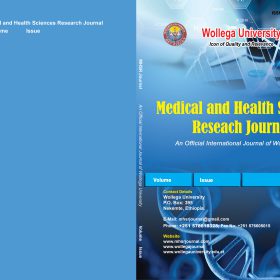HPTLC Finger Printing Analysis of Aqueous Root Extract of Rotula aquatica Lour. for Steroid and Terpenoid Contents
DOI:
https://doi.org/10.20372/mhsr.v1i1.84Keywords:
Rotula aquatica, HPTLC, Phytochemical, Steroids, TerpenoidsAbstract
The medicinal plants are considered to be the most important in the healing system due to their qualities. There is a high demand for the medicinal plants in pharmaceutical and cosmetic industry. The medicinal plants acquire these qualities due to the phyotchemicals present in them. The plant products are friendly to the user and poses minimum or no side effects hence they are preferred for treatment. The plants have many secondary metabolites that give them protection from different biotic and abiotic stresses. The objective of present work was to study the HPTLC fingerprinting of aqueous root extract of Rotula aquatica. A CAMAG HPTLC system equipped with LINOMAT 5 applicator, a TLC scanner3, REPROSTAR with 12 bit CCD camera and WIN CATS-4 software were used. In the present study aqueous extract of Rotula aquatica plant roots contains steroids and terpenoids in addition to different other components. The HPTLC fingerprinting profile developed for aqueous extract of Rotula aquatic will help in proper identification of compounds. By isolating and identifying marker compounds, new drugs can be formulated to treat various ailments.
Downloads
References
Aiyegoro, O.A., Akinpelu, D.A., Afolayan, A.J. and Okoh, A.I. (2008). Antibacterial activities of crude stem bark extracts of Distemonanthus benthamianus Baill. Journal of Biological Sciences 2: 356-361.
Chew, Y.L., Chan, E.W.L., Tan, P L. Lim, Y.Y., Stanslas, J. and Goh, J.K. (2011). Assessment of phytochemical content, polyphenolic composition, antioxidant and antibacterial activities of Leguminosae medicinal plants in Peninsular Malaysia. BMC Complementary and Alternative Medicine 11:1-10.
Gallo, F.R., Multari, G., Federici,E., Palazzino, G. and Giambenedetti, M. (2011). Chemical fingerprinting of Equisetum arvense L. using HPTLC densitometry and HPLC. Natural Product Letters 25: 1261-1270.
Gomathi, D., Ravikumar, G., Kalaiselvi, M., Vidya, B. and Uma, C. (2012). HPTLC fingerprinting analysis of Evolvulus alsinoides L. Journal of Acute Medicine, 2: 77- 82.
Hemlal, H. and Ravi, S. (2012). GC-MS, HPTLC and Antimicrobial analysis of root extracts of Pseudarthria viscida Wight and Arn and Desmodium gangeticum (Linn) DC. International Research Journal of Biological Sciences 1: 57-65.
Jain, M., Kapadia, R., Albert, S. and Mishra, S. (2011). Standardisation of Feronia limonia L. leaves by HPLC, HPTLC, physicochemical and histological parameters. Boletin Medicinalesy Aromaticas 10: 525-535.
Mamta, K., Abhishek, B. and Rohit (2010). Pharmacognostical evaluation on the root of Rotula aquatic Lour. International Journal of Pharma and Biosciences VI: 1-4.
Mariswamy, Y., Gnaraj, W.E. and Johnson, M. (2011). Chromatographic finger print analysis of steroids in Aerva lanata L by HPTLC technique. Asian Pacific Journal of Tropical Biomedicine 1: 428-433.
Mengi, S.A. and Bakshi, V.J. (2009). Evaluation of the aqueous extract of Rotula aquatica roots in acute and chronic inflammatory conditions in rats. Pharmaceutical Biology 47: 491-495
Mukherjee, P.K., Venkatesh, P. and Ponnusankar, S. (2010). Ethnopharmacology and integrative medicine- let the history tell the future. Journal of Ayurveda and Integrative medicine 1: 100-109.
Nicoletti, M. and Toniolo, C. (2012). HPTLC fingerprint analysis of plant stamina cells products. Journal of Chromatography and Separation Techniques 3: 1-4.
Parimala Devi, R., Kumari, B. Vijaya., Yadav Hiranmai, R. (2012). Assessment of a few non-enzymatic Anti Oxidants in Selected Fruits. International Journal of Research in Pharmacy and Science 2(3): 121-1307.
Piccin, A., Toniolo, C. and Nicoletti, M. (2012). Analytical tools for digestive plant extracts. Nutrifoods 11: 29-35.
Priya, B., Zade, S.R., Shaikh, A., Gahlot, M. and Joshi, P. (2013). In vitro antioxidant activity and determination of total phenolic, flavanoid contents of stems of Rotula aquatica Lour. International Journal of Pharmaceutical Sciences and Research 4: 3608-3614
Reich, E. and Widmer, V. (2009). Plant analysis 2008- Planar chromatography. Planta Medica 75: 711-718.
Selavamani, P., Sen, D.J. and Gupta, J.K. (2009). Pharmacological standardization of Commiphora berryi (Arn) Engl and phytochemical studies on its crude extracts. African Journal of Pharmacy and Pharmacology 3: 37-46.
Sophia, D., Ragavendran, P., Arulraj, C. and Gopalakrishnan,
V.K. (2011). In vitro antioxidant activity and HPTLC determination of n-hexane extract of Emilia sonchifolia (L.) DC. Journal of Basic and Clinical Pharmacy 2: 179- 183.
Tresina, P.S., Kala, M.J. and Mohan, V.R. (2012). HPTLC finger print analysis of phytocompounds and in vitro antioxidant activity of Eugenia floccosa Bedd. Bioscience Discovery 3: 296-311.
Tripathi, I.P., Mishra, M.K.R., Pardhi, Y., Dwivedi, A., Dwivedi, N., Kamal, A. and Gupta, P. (2012). HPLC analysis of methanolic extract of some medicinal plant leaves of myrtaceae family. Internationale Pharmaceutica Sciencia 2: 49-53.
Umesh, G.K. and Christina, A.J.M. (2011). Effect of Rotula aquatica Lour. on ethylene glycol induced urolithiasis in rats. International Journal of Drug development and Research 3: 273-280.
Yamunadevi, M., Wesely E.G. and Johnson, M. (2012). Chromatographic finger print studies on saponins of Aerva lanata (L.) Juss. ex Schultes by using HPTLC. International Journal of Current Pharmaceutical Research 4: 52-57.
Downloads
Published
How to Cite
Issue
Section
License
Copyright (c) 2023 Medical and Health Sciences Research Journal

This work is licensed under a Creative Commons Attribution-NonCommercial 4.0 International License.
Medical and Health Sciences Research Journal,
MHSR © 2023 Copyright; All rights reserved





